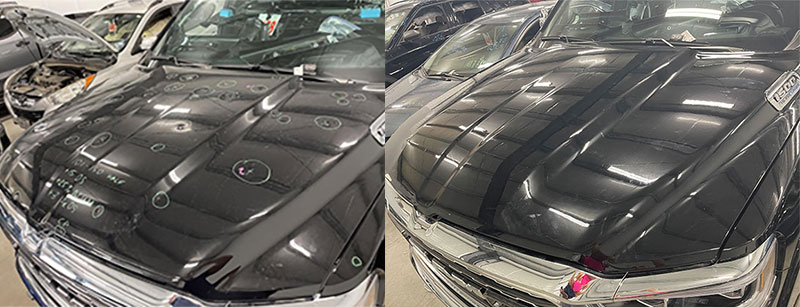Hailstorms are unpredictable forces of nature. They can render a perfectly functional vehicle into a patchwork of dents and dings in a matter of minutes. For automobile owners, the aftermath can incite not just aesthetic concerns but financial anxiety as well. What does it truly cost to repair hail damage? This inquiry dives into the world of automotive restoration, unearthing the average expenses, factors influencing these costs, and your options for navigating this tumultuous path.
On average, the cost of car hail damage repair varies significantly across different regions, types of damage, and vehicle makes. For instance, basic repairs can fall anywhere between $300 to $1,500, depending largely on the severity of the damage and the technique chosen for remediation. However, some extreme cases can escalate into the thousands, particularly if the hail has wreaked havoc on the paint or underlying structures, necessitating more comprehensive restoration efforts.
To understand the financial implications thoroughly, one must grasp the various types of repair methodologies available. The most common practice involves Paintless Dent Repair (PDR). PDR is a meticulous technique that allows technicians to massage the metal back to its original form without the need for repainting. This method is often preferable as it retains the vehicle’s original paint, thereby preserving resale value. The average cost for PDR usually ranges from $75 to $150 per dent. However, scaling this to larger areas with multiple dents may see overall costs escalate. For example, a vehicle afflicted by extensive hail damage might yield repair bills totaling between $1,000 to $3,000.
On the other hand, traditional bodywork methods could entail more extensive procedures. These typically necessitate applying fillers, sanding, and repainting, leading to costs that can leap from $1,500 to as much as $6,000 or more. While this method might be necessary for severe damage, it’s important to note that it often results in the loss of the original paint. This can decrease the vehicle’s value, a pivotal concern for many car owners.
Moreover, several factors influence these repair estimates. The first of these factors is, without doubt, the size and severity of the hailstones. Larger hailstones can dent and damage vehicles more severely, prompting more costly repairs. In many cases, hailstones measuring over one inch can be considered “large,” potentially leading to more extensive vehicle impairments.
The type of vehicle also plays a crucial role in your costs. Luxury vehicles or those with intricate body designs may incur significantly higher repair expenses due to specialized components or custom paint matching. Furthermore, older vehicles may be more challenging to repair owing to the availability of parts, thus affecting repair prices.
Location is also paramount. Regions that experience frequent hailstorms often have heightened competition among repair shops, which can influence pricing. Conversely, smaller towns with limited repair options might present fewer choices, potentially driving up costs due to a lack of competition. Additionally, the time of year can play a significant role, especially if demand surges after a widespread hailstorm. Repair shops may reflect this demand in their pricing strategies.
Insurance also becomes a pivotal player in navigations through the tumultuous realm of hail damage. Many comprehensive auto insurance policies cover hail damage repair. However, policyholders must consider their deductible—the amount one must pay out-of-pocket before insurance kicks in. If the repair costs fall below this threshold, you may find yourself bearing the entire financial burden of repairs. As such, it is crucial to ascertain your deductible level and evaluate whether it makes sense to file a claim.
When contemplating repairs, it is prudent to obtain multiple estimates from various repair shops. This is not only advisable, but it also empowers you to make a more informed decision. The variance in quotes can be surprising, reaffirming the importance of not settling for the first estimate presented. Furthermore, some shops may offer warranties on their repairs, which can mitigate future concerns regarding workmanship or materials.
Nevertheless, with the increased focus on sustainability and eco-friendliness, the choice of repair method is not merely a matter of finance. The adoption of PDR reflects a growing awareness of minimizing environmental impact. Cheaper, more eco-conscious solutions yield a dual benefit—repairs that preserve the integrity of the vehicle while contributing to broader environmental sustainability efforts.
Ultimately, experiencing hail damage can prompt a re-evaluation of our relationship with vehicles—their care, value, and sustainability. Though it might seem daunting to face repair costs after a storm, increased awareness of methods, insurance options, and environmental considerations can empower car owners to make informed choices. This journey towards restoring a vehicle may not only be about restoration in the physical sense but also in the broader commitment to understanding the environmental implications of our automotive choices.
In conclusion, while the financial impact of hail damage repair may initially evoke anxiety, taking a structured approach can elucidate the path forward. With knowledge about repair options, insurance implications, and ecological ramifications, automobile owners can shift perspective from one of despair to empowerment. Embrace the unknown—and navigate the world of car repairs with confidence.
